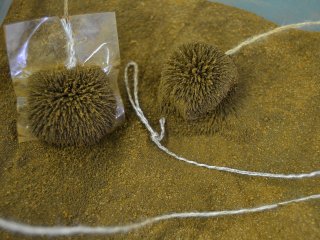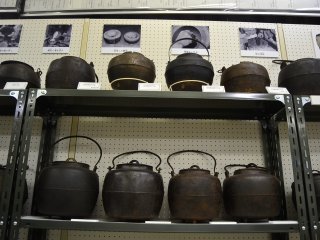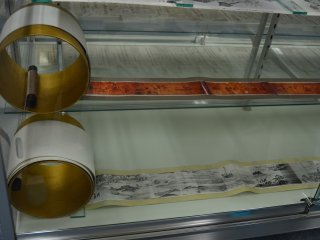When you see this building for the first time, you may not think that it is a museum. Referred to as Kuji Historic Folk Museum (Kuji-shi Rekishi Minzoku Shiryokan), this building has many impressive collections that can give a clue as to what life was like in Kuji in the past. There are four main exhibition halls. The first exhibition hall displays many collections of iron and steel that were produced in Kuji. Maybe not many people are aware of the fact that Kuji was formerly a major producer of iron and steel. Going to the next exhibition hall, you will come across exhibits relating to famous people who came from Kuji with various kinds of professions. From teachers, poets, to politicians. Go on to the third exhibition hall, and you will see ancient pottery that dates from the pre-historic era. Last but not least, you will find many household items donated by local people from Kuji that have a strong connection with the area.
Kuji Historical Folk Museum
In depth look at Kuji's distinctive history - for free!

Por Sarashanti
Community writer

Famous iconic clothes from Kuji worn by diving women, ama-san, who catch sea urchins and other shellfish using a net and metal hook (soegaki). (Photo: Mifthanzi Ariana Sarashanti)

Local sand taken from the Kuji area that contains iron. This is clearly demonstrated when the sand is touched directly with a magnet. (Photo: Mifthanzi Ariana Sarashanti)

Diorama that depicts iron manufacturing in Kuji in the Edo period (1605-1868). (Photo: Mifthanzi Ariana Sarashanti)

Categorized iron waste that came from the traditional manufacturing process (tatarabuki kiln) that can be seen in the diorama. (Photo: Mifthanzi Ariana Sarashanti)

Old iron teapots that were forged locally. (Photo: Mifthanzi Ariana Sarashanti)

Scrolls (emaki) that record the traditional manufacturing process of iron through text and pictures. (Photo: Mifthanzi Ariana Sarashanti)

Old coins. (Photo: Mifthanzi Ariana Sarashanti)

Reconstructed old pottery from the pre-historic era. (Photo: Mifthanzi Ariana Sarashanti)

Non-electric traditional freezer. (Photo: Mifthanzi Ariana Sarashanti)

A hand-driven machine traditionally used to remove the chaff from rice. (Photo: Mifthanzi Ariana Sarashanti)

Traditional spinning machine. (Photo: Mifthanzi Ariana Sarashanti)

Spears that were used for fishing. (Photo: Mifthanzi Ariana Sarashanti)
Explorar nas proximidades
Deixar um comentário
0 comentários no total
Reserve a sua viagem
Find a nearby hotel
Explore some of the best nearby hotels and deals for the perfect place to stay in Japan.
-
![O Castelo Original de Matsumoto O Castelo Original de Matsumoto]() 1
1O Castelo Original de Matsumoto
Nagano -
![Jardins do Este do Palácio Imperial Jardins do Este do Palácio Imperial]() 2
2Jardins do Este do Palácio Imperial
Tóquio -
![Top 10 Locais no Japão inspirados no Studio Ghibli Top 10 Locais no Japão inspirados no Studio Ghibli]() 3
3Top 10 Locais no Japão inspirados no Studio Ghibli
Cultura -
![8 Melhores Locais para Correr em Tóquio 8 Melhores Locais para Correr em Tóquio]() 4
48 Melhores Locais para Correr em Tóquio
Tóquio -
![Guia para Terramotos no Japão Guia para Terramotos no Japão]() 5
5Guia para Terramotos no Japão
Plano -
![A Casa de Satsuki e Mei A Casa de Satsuki e Mei]() 6
6A Casa de Satsuki e Mei
Aichi -
![Guia para Tufões no Japão Guia para Tufões no Japão]() 7
7Guia para Tufões no Japão
Plano -
![Parque Nacional de Shiretoko Parque Nacional de Shiretoko]() 8
8Parque Nacional de Shiretoko
Hokkaido -
![Caminhando pelo Belo Vale Kaeda Caminhando pelo Belo Vale Kaeda]() 9
9Caminhando pelo Belo Vale Kaeda
Miyazaki -
![Igreja Católica de Nossa Senhora de Akita Igreja Católica de Nossa Senhora de Akita]() 10
10Igreja Católica de Nossa Senhora de Akita
Akita
-
![Guia para Tufões no Japão Guia para Tufões no Japão]() 1
1Guia para Tufões no Japão
Plano -
![Festival de Lanternas Nara Tokae Festival de Lanternas Nara Tokae]() 2
2Festival de Lanternas Nara Tokae
Nara -
![Top 10 Locais no Japão inspirados no Studio Ghibli Top 10 Locais no Japão inspirados no Studio Ghibli]() 3
3Top 10 Locais no Japão inspirados no Studio Ghibli
Cultura -
![Gion Matsuri - Festival de Gion Gion Matsuri - Festival de Gion]() 4
4Gion Matsuri - Festival de Gion
Quioto -
![O Fantástico Vale Atera O Fantástico Vale Atera]() 5
5O Fantástico Vale Atera
Nagano -
![Aeroporto, Museu de Aviação, Sendai Aeroporto, Museu de Aviação, Sendai]() 6
6Aeroporto, Museu de Aviação, Sendai
Miyagi -
![Tokyo Game Show (TGS) Tokyo Game Show (TGS)]() 7
7Tokyo Game Show (TGS)
Chiba -
![Pagode Chureito, Fujiyoshida Pagode Chureito, Fujiyoshida]() 8
8Pagode Chureito, Fujiyoshida
Yamanashi -
![A Floresta de Bambu de Arashiyama A Floresta de Bambu de Arashiyama]() 9
9A Floresta de Bambu de Arashiyama
Quioto -
![Etiqueta em Santuários e Templos Etiqueta em Santuários e Templos]() 10
10Etiqueta em Santuários e Templos
Cultura































